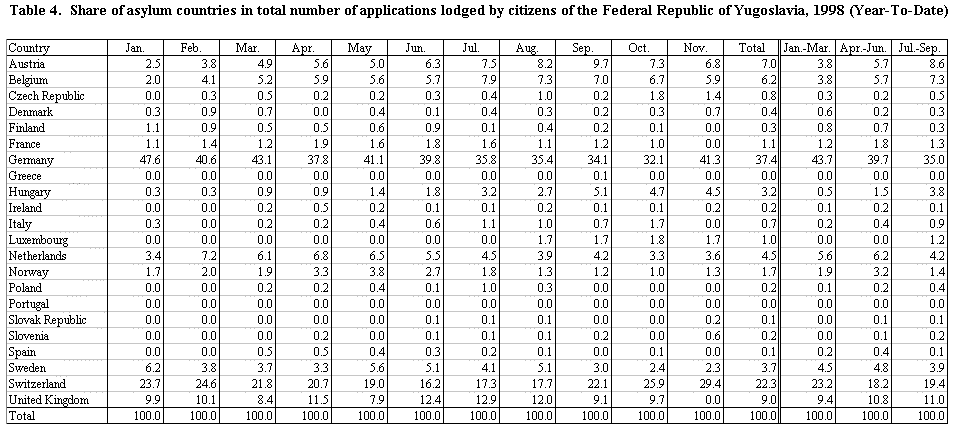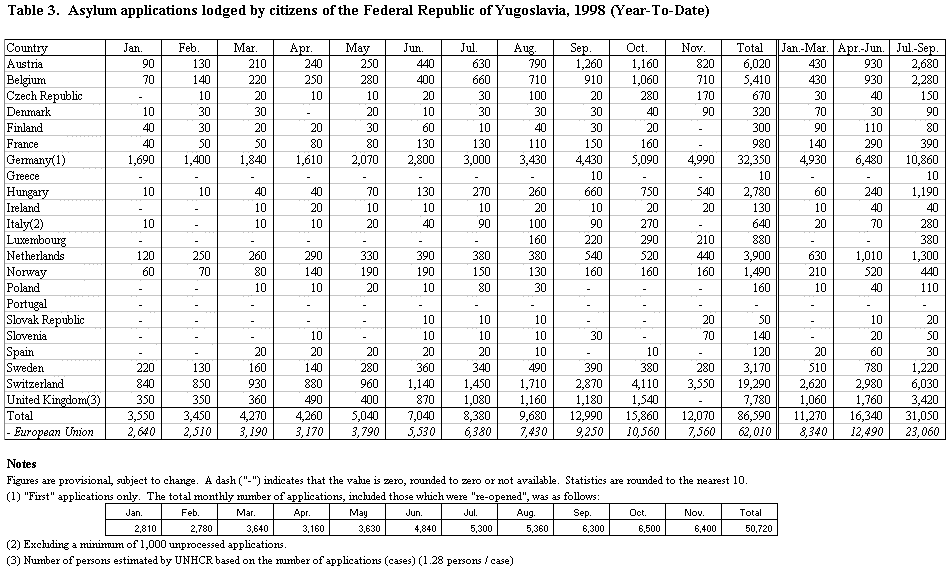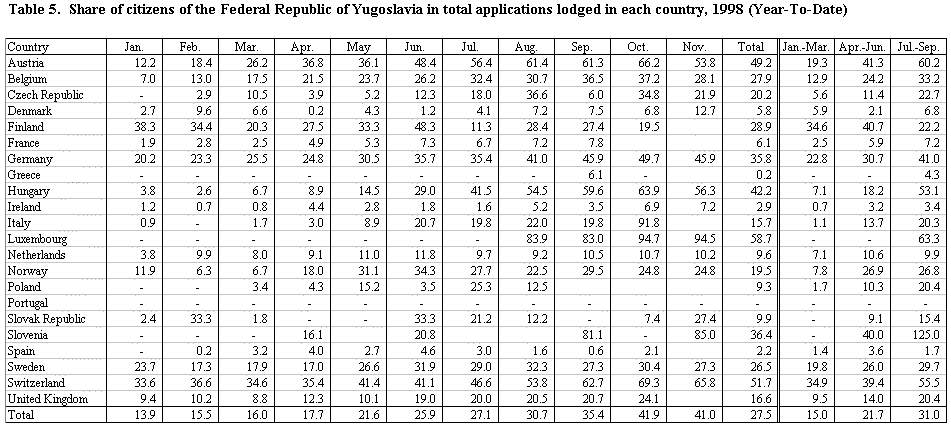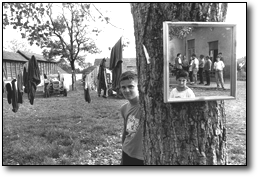
As diplomatic efforts to end the conflict in Kosovo intensify, the humanitarian situation on the ground continues to be grim. The fighting over the past month or so has driven an estimated 45,000 people from 40 villages. Some have trickled back to their homes but most are still displaced. Frequent clashes prevent aid organisations from reaching those in need. Much of the improvement brought by the October 27 cease-fire has now been wiped out by recurring hostilities.
It is estimated that 210,000 people remain displaced within Kosovo. Another 20,000 are in Albania and more than 30,000 in neighbouring Montenegro. Some 7,000 have fled to Bosnia and Herzegovina. Last year close to 100,000 Yugoslav nationals, mostly Kosovo Albanians, sought asylum in western Europe. The fighting has also affected Kosovo’s Serbian minority population which officials say is dwindling as more people leave.
Almost 20 percent of Kosovo’s pre-war population has been displaced or driven out of the country, in the biggest wave of displacement in Europe since the Bosnian war.
During the third quarter of 1998, some 31,000 citizens of the Federal Republic of Yugoslavia lodged an asylum application in Europe, twice as much as during the period April - June and almost three times the number of applications lodged during the first quarter. In October, almost 16,000 asylum applications were lodged by citizens of the Federal Republic of Yugoslavia, an increase of 22 per cent compared to the previous month (13,000 applications) and the highest monthly total so far (Table 3).
Countries which experienced a more than five-fold increase in asylum applications lodged by citizens of the Federal Republic of Yugoslavia in the third quarter (compared to the first) include Austria, Belgium, the Czech Republic, Hungary, Italy and Poland.
For the first time during 1998, the monthly number of applications of citizens from the Federal Republic of Yugoslavia fell in November, although the precise decrease can only assessed once all data for November have been made available. In the 12 countries for which data for November were available (all major asylum countries, except the United Kingdom), applications from citizens of the Federal Republic of Yugoslavia fell by 13 per cent in November, compared to the previous month (Table 3).
During the first 11 months of 1998, Germany received almost 40 per cent of all citizens from FRY who lodged an asylum application in Europe. Whereas this percentage fell from almost 50 per cent in January to 30 per cent in October, it again increased in November. Switzerland’s share of asylum applications lodged by citizens of FRY was around 20 percent during the first nine months of 1998, but increased to 26 per cent in October (the last month for which complete data are available) (Table 4).
Since September, Hungary has been the sixth major European destination country for asylum-seekers from the Federal Republic of Yugoslavia, ranking higher than France, the Netherlands and Sweden.
In October and November, four out of ten asylum-seekers in Europe originated from the Federal Republic of Yugoslavia, compared to 15 per cent during the first quarter and 22 per cent during the second (see Table 5).
During the first 11 months of 1998, asylum-seekers from the Federal Republic of Yugoslavia constituted some 50 per cent or more of all asylum applicants in Belgium (49%), Luxembourg (59%) and Switzerland (52%). In Hungary, citizens from the Federal Republic of Yugoslavia have accounted for more than half of all asylum applicants since August 1998. In Luxembourg, the share of asylum-seekers from FRY is currently the highest in Europe (more than 80%) (Table 5).

Table 4

Table 5

| Operations in the Federal Republic of Yugoslavia |  |
| Basic Facts | It
is estimated that only a part of Serbia's several hundred thousand refugees
will return to their places
f origin. UNHCR/A. Kiazinierakis |
| What we do | Provide protection and seek durable solutions for more than half a million refugees in the Federal Republic of Yugoslavia (FRY); help almost half of these refugees meet their basic daily needs; meet the protection and relief needs of internally displaced persons and others severely affected by the conflict in Kosovo; and support rehabilitation and return. | ||||||||||||||||||||||||||||||||||||||||||||||||||||||||||||||
| Whom we help | UNHCR
will assist all refugees who wish to repatriate voluntarily to Bosnia and
Herzegovina and to Croatia. The budget will include a provision to assist
50,000 persons with transport and a small travel allowance. Resettlement
of another 4,000 refugees will be facilitated. A total of 30,000 refugees
will benefit from income-generation and food production programmes, and
an additional 4,000 persons will be assisted with permanent housing, linked
to employment. A total of 225,500 refugees will receive some form of direct
humanitarian assistance (food and/or household items) during the first
six months of 1999. A review of refugees in need of assistance will be
conducted towards mid-1999. It is expected that the number of refugees
accommodated in collective centres will decrease from 40,000 to 30,000
during 1999 as a result of repatriation, resettlement and local integration.
Each month, UNHCR will help some 80 mandate refugees and asylum-seekers from countries outside the former Yugoslavia cover their daily needs pending the identification of a durable solution (repatriation or resettlement). UNHCR will provide
immediate relief assistance to some 300,000 persons in Kosovo who were
displaced or otherwise seriously affected by the 1998 crisis there. The
agency will also help them rebuild their lives. UNHCR will cover the daily
requirements of another 65,000 persons, displaced from Kosovo into Montenegro
and parts of Serbia other than Kosovo. These persons will also be assisted
should they choose, voluntarily, to return to their homes in Kosovo. Some
35,000 persons who found refuge in countries outside the Federal Republic
of Yugoslavia, such as Albania and Bosnia and Herzegovina, will be assisted
upon their voluntary repatriation to Kosovo.
|
||||||||||||||||||||||||||||||||||||||||||||||||||||||||||||||
| Our requirements | US$
60,747,377
|
||||||||||||||||||||||||||||||||||||||||||||||||||||||||||||||
| Our offices | Belgrade,
Kosovska Mitrovica, Kraljevo, Pec, Podgorica, Pristina, Prizren, Novi Sad.
|
||||||||||||||||||||||||||||||||||||||||||||||||||||||||||||||
| Our partners | Care International (Care), Catholic Relief Services (CRS), Children's Aid Direct (CAD), Commissioner for Displaced Persons in Montenegro (MCDP), Commissioner for Refugees in Serbia (SCR), Commission for Real Property Claims (CRPC), Danish Refugee Council (DRC), Handicap International (HI), Hi Neighbour (HN), Humanitarian Law Centre (HLC), Institute for Mental Health (IMH), International Federation of Red Cross and Red Crescent Societies (IFRC), International Organization for Migration (IOM), International Orthodox Christian Charities (IOCC), International Rescue Committee (IRC), Italian Consortium of Solidarity (ICS), Japanese Emergency NGOs (JEN), Médecins Sans Frontières (MSF), Norwegian Refugee Council (NRC), ODGOVOR, OXFAM, Radio B92, Save the Children Fund UK (SCF/UK), Swiss Disaster Relief (SDR). | ||||||||||||||||||||||||||||||||||||||||||||||||||||||||||||||
|
Background
|
|||||||||||||||||||||||||||||||||||||||||||||||||||||||||||||||
| As
a result of the 1992-1995 war in the former Yugoslavia, refugees from both
Bosnia and Herzegovina and from Croatia fled to the Federal Republic of
Yugoslavia (FRY). During the refugee census conducted in 1996, a total
of 566,000 refugees were registered. Since then, some 89,000 are estimated
to have found a durable solution through repatriation, resettlement or
naturalization. However, during the past year, a new group of some 50,000
persons moved from the Eastern Danubian region of Croatia to the FRY in
search of asylum.
The 1998 violence in Kosovo between Serb forces and Kosovo Albanians has led to the displacement of as many as 300,000 persons. Some 24,000 fled to Albania, several thousands sought refuge in Bosnia and Herzegovina, and others fled to the Former Yugoslav Republic of Macedonia, to Turkey and to various other countries in Europe. Another 45,000 found refuge in the Federal Republic of Yugoslavia, Republic of Montenegro, while an estimated 20,000 persons moved to locations elsewhere in Serbia. However, most of those uprooted by the conflict — an estimated 200,000 — have stayed in Kosovo, while at least another 100,000 in Kosovo are seriously affected by the conflict and in need of assistance. The economic conditions in the FRY deteriorated during 1998. A major devaluation in early 1998 was followed by inflation, thus further limiting the opportunities for refugees to integrate in the country. More than 40 per cent of the more than half a million refugees in the FRY still depend on humanitarian assistance. The previously generous health care and social welfare system in the country has almost collapsed. Though refugees have, in principle, free access to medical care, in practice, various medical interventions and drugs need to be paid for directly by the patients. This situation affects both citizens and refugees (especially children and the elderly); but refugees are in a much more vulnerable position as many cannot rely on a social security network of relatives and friends to provide support. The situation
in Kosovo contributed to a further deterioration of the economy in the
FRY. Additional taxes were imposed in the country while sanctions were
renewed, undermining the country's ability to revive its economy. The FRY
has no access to support from international financial development institutions
and its dubious status in the world directly affects its inhabitants, in
particular those refugees and internally displaced persons who are already
living on the edge of survival.
|
|||||||||||||||||||||||||||||||||||||||||||||||||||||||||||||||
| Those in need of protection and assistance | Almost
three years after the conclusion of the General Framework Agreement for
Peace in Bosnia and Herzegovina and more than two years after the signing
of the Agreement on Normalisation of Relations between the Republic of
Croatia and the Federal Republic of Yugoslavia, there are still a total
of 527,000 refugees from Croatia and Bosnia and Herzegovina in the FRY.
Though both agreements include provisions for the return of refugees and
displaced persons to their areas of previous residence, actual repatriation
has been limited due to, among other reasons, security considerations and
lack of adequate housing in the places of intended return.
A food aid needs-assessment mission carried out in March 1998 by UNHCR and the World Food Programme (WFP), together with representatives from ECHO, the Government of the United States of America and the International Federation of Red Cross and Red Crescent Societies (IFRC), concluded that a total of 225,500 refugees from the former Yugoslavia require food assistance under a humanitarian relief programme. This includes the most vulnerable refugees who are accommodated in collective centres throughout the country and who number some 40,000 as of late 1998. Others include those with special needs, such as single-parent families, disabled or chronically ill persons, elderly and other destitute refugees who have no resources to support themselves and who depend on external help. Some internally displaced persons in Kosovo returned home prior to the start of the 1998/1999 winter. Others remain displaced, most of them finding temporary shelter with local residents. Many of the internally displaced persons who have been able to return home have found their houses partially destroyed, and emergency assistance is provided to them by United Nations agencies, NGOs and local authorities to render at least part of the houses habitable during the winter. Those internally displaced persons who could not return to their own homes due to security considerations, or because their houses had been completely destroyed, are assisted where they are. In Kosovo itself, the fighting has damaged all sectors of life, including housing, health and education facilities, trading, communications and infrastructure. Even before the major violence started this year, the economy in Kosovo was weak, with unemployment levels reaching 75 per cent, and with many families surviving on support from relatives abroad. Health and education services were provided through parallel channels, of which one was exclusively for the Kosovo Albanian community. While before the clashes a considerable number of Kosovo Albanians were receiving humanitarian assistance by international NGOs, the 1998 clashes in Kosovo made a large part of the population totally dependent on external support even for the most immediate daily requirements. Mandate refugees
and asylum-seekers from countries outside the former Yugoslavia require
both protection and assistance. The numbers are limited; but most remain
completely dependent on support from UNHCR until repatriation or resettlement
becomes an available option.
|
||||||||||||||||||||||||||||||||||||||||||||||||||||||||||||||
| Objectives | UNHCR works to support durable solutions for refugees in the Federal Republic of Yugoslavia by facilitating voluntary repatriation, resettlement and local integration, while continuing to provide essential relief aid to the most vulnerable groups. The agency also provides protection and assistance to internally displaced persons and others in Kosovo, enabling them to return home and rebuild their lives; helps sensitize the public and national institutions to the issues of asylum, refugee status and refugee rights; and supports NGOs, both national and international, and helps strengthen their capacity to provide humanitarian assistance. | ||||||||||||||||||||||||||||||||||||||||||||||||||||||||||||||
| Protection and Solutions | Protection
activities concern all refugees in the country and include offering counselling
to individuals, intervening on their behalf with the relevant authorities,
supporting the granting of citizenship, and monitoring refugees to ensure
that their rights to health and social care, to education and employment
are maintained or — in the case of mandate refugees and asylum-seekers
from countries outside the former Yugoslavia — are acknowledged and honoured.
UNHCR supports the work of the Commission for Real Property Claims which enables refugees to receive confirmation of their rights to property left behind in Bosnia and Herzegovina. Close cooperation with the relevant authorities in Croatia and the FRY and support to refugees from Croatia who would also like to reclaim their left property is also envisaged. All these activities support the development of durable solutions, whether through repatriation or through local integration. UNHCR hopes to facilitate the repatriation of some 50,000 refugees to Bosnia and Herzegovina and to Croatia during 1999. Refugees who, because of their background, are not able to repatriate to their own country or integrate in the FRY, will be considered for resettlement. This also applies to mandate refugees. It is foreseen that some 4,000 refugees from the former Yugoslavia will be resettled during 1999, while the possibilities for resettlement (or repatriation) of the limited number of mandate refugees will be reviewed case-by-case. Advocacy and
Assistance
Assistance in
the form of food, household items, shelter material and support to the
areas' infrastructures, will be required for at least half of those affected.
As different ethnic groups are involved in the conflict in Kosovo, it is
important that community- and peace-building activities are launched.
|
||||||||||||||||||||||||||||||||||||||||||||||||||||||||||||||
| Women and children | Women are encouraged to participate in income-generation projects and special projects for children and for the elderly have been developed. UNHCR is launching new initiatives to help children affected by the Kosovo crisis which include psycho-social counselling and support and the provision of school facilities and learning materials. Hygiene parcels for babies and small children are distributed to ensure that basic supplies are available. The impact of the Kosovo crisis on women has been substantial. Women who used to live in relative isolation are finding themselves assuming much larger responsibilities which extend beyond the family. To help them adapt to their new roles, women will be given opportunities to exchange their experiences and ideas with one another. | ||||||||||||||||||||||||||||||||||||||||||||||||||||||||||||||
| Environment | The displacement of large numbers of persons in Kosovo has made it necessary to organize the supply of firewood for heating and cooking during the winter. Random cutting of firewood occurred during displacement. So far, the damage is limited. | ||||||||||||||||||||||||||||||||||||||||||||||||||||||||||||||
| Coordination | UNHCR
is the lead agency in the international humanitarian assistance programme
to refugees and internally displaced persons in the FRY. Regular meetings
are held at various levels with relevant government agencies, other United
Nations agencies and with NGOs, both local and international, to review
requirements and available resources and to coordinate delivery of assistance.
UNHCR provides radio escorts to humanitarian convoys carrying a variety
of relief supplies provided by United Nations agencies and by NGOs.
Close cooperation
and coordination among humanitarian agencies in the FRY is a necessity
for the operational capability of the NGOs. While authorities in the FRY
accept the presence of international NGOs, the agencies cannot be registered
because of a legislative impediment. A draft law to redress this problem
is under consideration; meanwhile NGOs depend on agencies like the International
Committee of the Red Cross and UNHCR to be able to operate in the country.
|
||||||||||||||||||||||||||||||||||||||||||||||||||||||||||||||
| Budget
US$
|
|||||||||||||||||||||||||||||||||||||||||||||||||||||||||||||||
* Includes costs
for protection, monitoring and coordination.
|
|||||||||||||||||||||||||||||||||||||||||||||||||||||||||||||||